Home | Category: Languages and Writing
CUNEIFORM
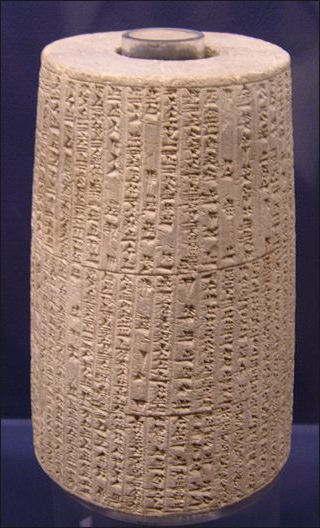
Nebuchadnezzar Barrel cylinder Cuneiform, the script language of ancient Sumer and Mesopotamia, consists of small, repetitive impressed characters that look more like wedge-shape footprints than what we recognize as writing. Cuneiform (Latin for "wedge shaped") appears on baked clay or mud tablets that range in color from bone white to chocolate to charcoal. Inscriptions were also made on pots and bricks. Each cuneiform sign consists of one or more wedge-shaped impressions that are made with three basic marks: a triangle, a line or curbed lines made with dashes.
Cuneiform (pronounced “cune-AY-uh-form”) was devised by the Sumerians more than 5,200 years ago and remained in use until about A.D. 80 A.D. when it was replaced by the Aramaic alphabet Jennifer A. Kingson wrote in the New York Times: "Evolving roughly at the same time as early Egyptian writing, it served as the written form of ancient tongues like Akkadian and Sumerian. Because cuneiform was written in clay (rather than on paper on papyrus) and important texts were baked for posterity, a large number of readable tablets have survived to modern times. Many of them written by professional scribes who used a reed stylus to etch pictograms into clay. [Source: Jennifer A. Kingson, New York Times November 14, 2016]
Cuneiform was used by speakers of 15 languages over 3,000 years. The Sumerians, Babylonians and Eblaites had large libraries of clay tablets. The Elbaites wrote in columns and used both sides of the tablets. The latest datable tablet, from Babylon, described the planetary positions for A.D. 74-75.
The University of Pennsylvania Museum of Archaeology and Anthropology has one of the world’s largest collections of cuneiform tablets from early Mesopotamia. Yale also has a bunch, including a tablets of meal recipes.
Categories with related articles in this website: Mesopotamian History and Religion (35 articles) factsanddetails.com; Mesopotamian Culture and Life (38 articles) factsanddetails.com; First Villages, Early Agriculture and Bronze, Copper and Late Stone Age Humans (50 articles) factsanddetails.com Ancient Persian, Arabian, Phoenician and Near East Cultures (26 articles) factsanddetails.com
Websites and Resources on Mesopotamia: Ancient History Encyclopedia ancient.eu.com/Mesopotamia ; Mesopotamia University of Chicago site mesopotamia.lib.uchicago.edu; British Museum mesopotamia.co.uk ; Internet Ancient History Sourcebook: Mesopotamia sourcebooks.fordham.edu ; Louvre louvre.fr/llv/oeuvres/detail_periode.jsp ; Metropolitan Museum of Art metmuseum.org/toah ; University of Pennsylvania Museum of Archaeology and Anthropology penn.museum/sites/iraq ; Oriental Institute of the University of Chicago uchicago.edu/museum/highlights/meso ; Iraq Museum Database oi.uchicago.edu/OI/IRAQ/dbfiles/Iraqdatabasehome ; Wikipedia article Wikipedia ; ABZU etana.org/abzubib; Oriental Institute Virtual Museum oi.uchicago.edu/virtualtour ; Treasures from the Royal Tombs of Ur oi.uchicago.edu/museum-exhibits ; Ancient Near Eastern Art Metropolitan Museum of Art www.metmuseum.org
Archaeology News and Resources: Anthropology.net anthropology.net : serves the online community interested in anthropology and archaeology; archaeologica.org archaeologica.org is good source for archaeological news and information. Archaeology in Europe archeurope.com features educational resources, original material on many archaeological subjects and has information on archaeological events, study tours, field trips and archaeological courses, links to web sites and articles; Archaeology magazine archaeology.org has archaeology news and articles and is a publication of the Archaeological Institute of America; Archaeology News Network archaeologynewsnetwork is a non-profit, online open access, pro- community news website on archaeology; British Archaeology magazine british-archaeology-magazine is an excellent source published by the Council for British Archaeology; Current Archaeology magazine archaeology.co.uk is produced by the UK’s leading archaeology magazine; HeritageDaily heritagedaily.com is an online heritage and archaeology magazine, highlighting the latest news and new discoveries; Livescience livescience.com/ : general science website with plenty of archaeological content and news. Past Horizons: online magazine site covering archaeology and heritage news as well as news on other science fields; The Archaeology Channel archaeologychannel.org explores archaeology and cultural heritage through streaming media; Ancient History Encyclopedia ancient.eu : is put out by a non-profit organization and includes articles on pre-history; Best of History Websites besthistorysites.net is a good source for links to other sites; Essential Humanities essential-humanities.net: provides information on History and Art History, including sections Prehistory
Sumerian Writing
Clay tablets with pictographs appeared around 4000 B.C. The earliest with Sumerian writing appeared around 3200 B.C. Around 2,500 B.C., Sumerian writing evolved into partial syllabic script capable of recording the vernacular. A Sumerian clay tablet from around 3200 B.C. inscribed in wedgelike cuneiform with a list of professions “is among the earliest examples of writings that we know of so far,” according to the University of Chicago’s Oriental Institute’ director, Gil J. Stein. [Source: Geraldine Fabrikant. New York Times, October 19, 2010]

Cuneiform tablet for beer, bread and oil from Ur III period (2100-2000BC)
The Sumerian are credited with inventing writing around 3200 B.C. based on symbols that showed up perhaps around 8,000 B.C. What distinguished their markings from pictograms is that theye were symbols representing sounds and abstract concepts instead of images. No one knows who the genius was who came up with this idea. The exact date of early Sumerian writing is difficult to ascertain because the methods of dating tablets, pots and bricks on which the oldest tablets with writing were found are not reliable.
By around 3200 B.C., the Sumerians had developed an elaborate system of pictograph symbols with over 2,000 different signs. A cow, for example, was represented with a stylized picture of a cow. But sometimes it was accompanied by other symbols. A cow symbols with three dots, for example, meant three cows.
By around 3100 B.C., these pictographs began representing sounds and abstract concepts. A stylized arrow, for example, was used to represent the word "ti" (arrow) as well as the sound "ti," which would have been difficult to depict otherwise. This meant individual signs could represent both words and syllables within a word.
The first clay tablets with Sumerian writing were found in the ruins of the ancient city of Uruk. It is no known what the said. They appear to have been list of rations of foods. The shapes appear to have been based on objects they represent but there is no effort to be naturalistic portrayals The marks are simple diagrams. So far over a half a million tablets and writing boards with cuneiform writing have been discovered.
John Alan Halloran of sumerian.org wrote: “When the Sumerians invented their writing system around 5400 years ago, it was a pictographic and ideographic system like the Chinese...Yes. Some of the Sumerian ideograms gradually became used as syllabograms, which included the vowel indications. Writing on clay was an inexpensive yet permanent way of recording transactions. The cultural influence of the Sumerians upon later Mesopotamian peoples was enormous. Cuneiform writing has been found at Amarna in Egypt, in the form of an alphabet at Ugarit, and among the Hittites who used it to render their own Indo-European language.” [Source: John Alan Halloran, sumerian.org]
Book: “A Manual of Sumerian Grammar and Texts,” by John L. Hayes is a good introduction to Sumerian writing.
Evolution of the Earliest Sumerian Writing

proto cuneiform
Ira Spar of the Metropolitan Museum of Art wrote: According to the Metropolitan Museum of Art: “Some of the earliest signs inscribed on the tablets picture rations that needed to be counted, such as grain, fish, and various types of animals. These pictographs could be read in any number of languages much as international road signs can easily be interpreted by drivers from many nations. Personal names, titles of officials, verbal elements, and abstract ideas were difficult to interpret when written with pictorial or abstract signs. [Source: Spar, Ira. "The Origins of Writing", Heilbrunn Timeline of Art History, New York: The Metropolitan Museum of Art, October 2004 metmuseum.org \^/]
“A major advance was made when a sign no longer just represented its intended meaning, but also a sound or group of sounds. To use a modern example, a picture of an "eye" could represent both an "eye" and the pronoun "I." An image of a tin can indicates both an object and the concept "can," that is, the ability to accomplish a goal. A drawing of a reed can represent both a plant and the verbal element "read." When taken together, the statement "I can read" can be indicated by picture writing in which each picture represents a sound or another word different from an object with the same or similar sound. \^/
“This new way of interpreting signs is called the rebus principle. Only a few examples of its use exist in the earliest stages of cuneiform from between 3200 and 3000 B.C. The consistent use of this type of phonetic writing only becomes apparent after 2600 B.C. It constitutes the beginning of a true writing system characterized by a complex combination of word-signs and phonograms—signs for vowels and syllables—that allowed the scribe to express ideas. By the middle of the third millennium B.C., cuneiform primarily written on clay tablets was used for a vast array of economic, religious, political, literary, and scholarly documents.” \^/
Scribes and the Production of Cuneiform Tablets
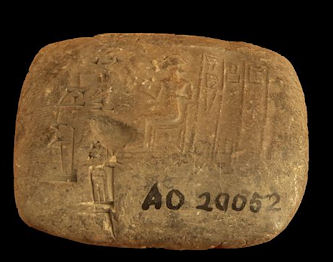
daily salary in Ur Cuneiform symbols were made by scribes who used a stylus — with a triangular tip cut from reed — to make impressions on damp clay. The reeds could make straight lines and triangles but could not easily make curved lines. Different characters were made by superimposing identical triangles in different combinations. Complex characters had around 13 triangles. The moistened tablets were left to dry in the hot sun. After archaeologists excavate the tablets they are carefully cleaned and baked for preservation. The process is expensive and slow.
Many cuneiform tablets are dated by the year, month and day. Tablets from monarchs, ministers and other important people were impressed with their seal, which was applied on the wet clay like a paint roller with a cylinder seal. Some cylinder seals produced reliefs that were quite elaborate, made up of scores of images and markings. Important messages were encased in an "envelope" of more clay to insure privacy.
Ancient Mesopotamia writing - and also reading - was a professional rather than a general skill. Being a scribe was an honorable profession. Professional scribes prepared a wide range of documents, oversaw administrative matters and performed other essential duties.Some scribes could write very fast. One Sumerian proverb went: "A scribe whose hands move as fast the mouth, that's a scribe for you."
One of the highest positions in Mesopotamia society was the scribe, who worked closely with the king and the bureaucracy, recording events and tallying up commodities. The kings were usually illiterate and they were dependent on the scribes to make their wishes known to their subjects. Learning and education was primarily the provenance of scribes.
Scribes were the only formally educated members of society. They were trained in the arts, mathematics, accounting and science. They were employed mainly at palaces and temples where their duties included writing letters, recording sales of land and slaves, drawing up contracts, making inventories and conducting surveys. Some scribes were women.
See Education
Subjects and Contents of Cuneiform Tablets
 Most of the early writing was used to make lists of commodities. The writing system is believed to have developed in response to an increasingly complex society in which records needed to be kept on taxes, rations, agricultural products and tributes to keep society running smoothly. The oldest examples of Sumerian writing were bills of sales that recorded transactions between a buyer and seller. When a trader sold ten head of cattle he included a clay tablet that had a symbol for the number ten and a pictograph symbol of cattle.
Most of the early writing was used to make lists of commodities. The writing system is believed to have developed in response to an increasingly complex society in which records needed to be kept on taxes, rations, agricultural products and tributes to keep society running smoothly. The oldest examples of Sumerian writing were bills of sales that recorded transactions between a buyer and seller. When a trader sold ten head of cattle he included a clay tablet that had a symbol for the number ten and a pictograph symbol of cattle.
The Mesopotamians could also be described as the worlds first great accountants. The recorded everything that was consumed in the temples on clay tablets and placed them in the temple archives. Many of the tablets recovered were lists of items like this. They also listed "errors and phenomena" that seemed to result in divine retribution such as sickness or bad weather.
Cuneiform writing began mainly as a means of keeping records but developed into a full blown written language that produced great works of literature such as the Gilgamesh story. By 2500 B.C. Sumerian scribes could write almost anything with 800 or so cuneiform signs, including myths, fables, essays, hymns, proverbs, epic poetry, lamentations, laws, lists of astronomical events, list of plants and animals, medical texts with lists ailments and their herbal . There are tablets that record intimate correspondence between friends.
Documents stored in libraries maintained by a succession of rulers. Tablets reported on international trade, described different jobs, kept track of cattle allotments to civil servants and recorded grain payments to the king.
One of the most famous Sumerian tablets contain a story about a great flood that destroyed Sumer. It is virtually the same story ascribed to Noah in the Old Testament. The same tablets also contain “ The Story of Gilgamesh” .
The world oldest known prescriptions, cuneiform tablets dating back to 2000 B.C. from Nippur, Sumer, described how to make poultices, salves and washes. The ingredients, which included mustard, fig, myrrh, bat dropping, turtle shell powder, river silt, snakeskins and "hair from the stomach of a cow," were dissolved into wine, milk and beer.
The oldest known recipe dates back to 2200 B.C. It called for snake skin, beer and dried plums to be mixed and cooked. Another tablet from the same period has the oldest recipe for beer. Babylonian tablets now housed at Yale University also listed recipes. One of the two dozen recipes, written in a language only deciphered in the last century, described making a stew of kid (young goat) with garlic, onions and sour milk. Other stews were made from pigeon, mutton and spleen.
Sumerian Writing and Other Languages
The Sumerian language endured in Mesopotamia for about a thousand years. The Akkadians, the Babylonians, Elbaites, Elamites, Hittites, Hurrians, Ugaritans, Persians and the other Mesopotamian and Near Eastern cultures that followed the Sumerians adapted Sumerian writing to their own languages.
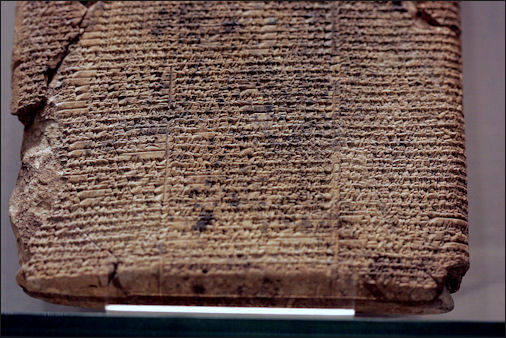
Laments on the ruin of Ur
Written Sumerian was adopted with relatively few modifications by the Babylonians and Assyrians. Other peoples such as Elamites, Hurrians, and Ugaritans felt that mastering the Sumerian system was too difficult and devised a simplified syllabary, eliminating many of the Sumerian word-signs.
Archaic Sumerian, the earliest written language in the world, remains as one of the written languages that have not been deciphered. Others include the Minoan language of Crete; the pre-Roman writing from the Iberian tribes of Spain; Sinaitic, believed to be a precursor of Hebrew; Futhark runes from Scandinavia; Elamite from Iran; the writing of Mohenjo-Dam, the ancient Indus River culture; and the earliest Egyptian hieroglyphics;
Sumerian Writing Spreads to the Akkadians
John Alan Halloran of sumerian.org wrote: “The fact that the Sumerians shared their land with Semitic-speaking Akkadians was important because the Akkadians had to turn the Sumerian logographic writing into phonetic syllabic writing in order to use cuneiform to represent phonetically the spoken words of the Akkadian language. [Source: John Alan Halloran, sumerian.org]
“Certain Sumerian cuneiform signs began to be used to represent phonetic syllables in order to write the unrelated Akkadian language, whose pronunciation is known from being a member of the Semitic language family. We have a lot of phonetically written Akkadian starting from the time of Sargon the Great (2300 B.C.). These phonetic syllable signs also occur as glosses indicating the pronunciation of Sumerian words in the lexical lists from the Old Babylonian period. This gives us the pronunciation of most Sumerian words. Admittedly the 20th century saw scholars revise their initial pronunciation of some signs and names, a situation that was not helped by the polyphony of many Sumerian ideographs. To the extent that Sumerian uses the same sounds as Semitic Akkadian, then, we know how Sumerian was pronounced. Some texts use syllabic spelling, instead of logograms, for Sumerian words. Words and names with unusual sounds that were in Sumerian but not in the Semitic Akkadian language can have variant spellings both in Akkadian texts and in texts written in other languages; these variants have given us clues to the nature of the non-Semitic sounds in Sumerian. [Ibid]
“In fact, bilingual Sumerian-Akkadian dictionaries and bilingual religious hymns are the most important source for arriving at the meaning of Sumerian words. But sometimes the scholar who studies enough tablets, such as the accounting tablets, learns in a more precise way to what a particular term refers, since the corresponding term in Akkadian may be very general.”
Babylonian and Elbaite Writing
At Sippar, a Babylonian site just south Baghdad, Iraqi archaeologists discovered an extensive library in the 1980s. A wide variety of tablets were found, including ones that contained literary works, dictionaries, prayers, omens, incantations, astronomical records — still arranged on shelves.
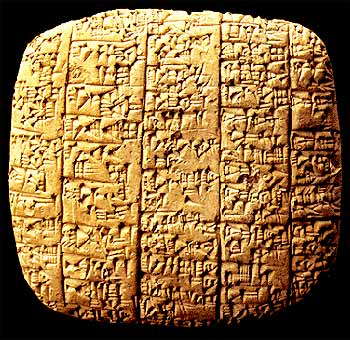
Ebla tablet A library with 17,000 clay tablets was discovered at Ebla in the 1960s. Most of tablets were inscribed with commercial records and chronicles like those found in Mesopotamia. Describing the importance of the tablets, Italian archaeologist Giovanni Pettinato told National Geographic, "Remember this: All the other texts of this period recovered to date are not total a forth of those from Ebla."
The tablets are mostly around 4,500 years old. They were written in the oldest Semitic language yet identified and deciphered with oldest know bilingual dictionary, written in Sumerian (a language already deciphered) and Elbaite. The Elbaites wrote in columns and used both sides of the tablets. Lists of figures were separated from the totals by a blank column. Treaties, description of wars and anthems to the gods were also recorded on tablets.
Ebla's writing is similar to that of the Sumerians, but Sumerian words are used to represent syllables in the Eblaite Semitic language. The tablets were difficult to translate because the scribes were bilingual and switched back and forth between Sumerian and the Elbaite language making it difficult for historians to figure which was which.
The oldest scribe academies outside of Sumer have been found in Ebla. Because the cuneiform script found on the Ebla tablets was so sophisticated, Pettinato said "one can only conclude that writing had been in use at Ebla for a long time before 2500 B.C."
Cuneiform tablets found in Ebla mention the cities of Sodom and Gomorrah and contain the name of David. They also mention Ab-ra-mu (Abraham), E-sa-um (Esau) and Sa-u-lum (Saul) as well as a knight named Ebrium who ruled around 2300 B.C. and bears an uncanny resemblance to Eber from the Book of Genesis who was the great-great grandson of Noah and the great-great-great-great grandfather of Abraham. Some scholars suggest that Biblical reference are overstated because the divine name yahweh (Jehovah) is not mentioned once in the tablets.
Ugarites and the First Alphabet
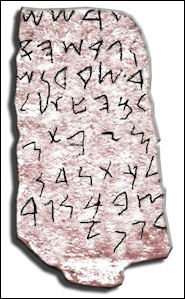
Phoenician alphabet
based on Ugaraite alphabet According to the Guinness Book of Records, the earliest example of alphabetic writing was a clay tablet with 32 cuneiform letters found in Ugarit, Syria and dated to 1450 B.C. The Ugarits condensed the Eblaite writing, with its hundreds of symbols, into a concise 30-letter alphabet that was the precursor of the Phoenician alphabet.
The Ugarites reduced all symbols with multiple consonant sounds to signs with a single consent sound. In the Ugarite system each sign consisted of one consonant plus any vowel. That the sign for “p” could be “pa,” “pi” or “pu.” Ugarit was passed on to the Semitic tribes of the Middle east, which included the Phoenician, Hebrews and later the Arabs.
Ugarit, an important 14th century B.C. Mediterranean port on the Syrian coast, was the next great Canaanite city to arise after Ebla. Tablets found at Ugarit indicated it was involved in the trade of box and juniper wood, olive oil, wine.
Ugarit texts refer to deities such as El, Asherah, Baak and Dagan, previously known only from the Bible and a handful of other texts. Ugarit literature is full of epic stories about gods and goddesses. This form of religion was revived by the early Hebrew prophets. An 11-inch-high silver-and-gold statuette of a god, circa 1900 B.C., unearthed at Ugarit in present-day Syria.
Cuneiform Tablets as Historical Sources
Writing on the sun-baked tablets, preserved in the dry climate of Mesopotamia have survive the ravages of time better than the earliest writing of other ancient civilizations in Egypt, China, India and Peru, which used perishable materials such as papyrus, wood, bamboo, palm leaves and cotton and wool twine that have been largely lost to time. Scholars have access to more original documents from Sumer and other Mesopotamian culture than they do from ancient Egypt, Greece or Rome.
The existence of cuneiform was not known until travelers in the Near East in the early 1600s began returning home with strange "chicken scratching" that were regarded as decorations not writing. A large archives of Sumerian cuneiform records was found in sacred Nippur. Some 20,000 cuneiform tablets were discovered in a 260-room place in Mari, a major Mesopotamian trading center that was ruled by Semitic-speaking tribes. Texts from Assyrian tablets established dates of events in Israelite history and confirmed parts of the Bible.

Ugaritic letters
The Journal of Cuneiform Studies is authoritative periodical on Mesopotamian writing. The University of Pennsylvania contains the world's largest collection of Sumerian cuneiform tablets. Of about 10,000 known Sumerian tablets, the University of Pennsylvania contains about 3,500 of them.
Deciphering Cuneiform
The word cuneiform — Latin for ''wedge-shaped'' — was coined by Thomas Hyde in 1700. Italian nobleman Pietro della Valle was the first to publish facsimile copies of cuneiform in 1658. The first copies from cuneiform accurate enough to form a basis for future decipherment would appear more than a century later, in 1778, the work of Carsten Niebuhr of Denmark.
Comprehension of the ancient script would come nearly a century after that, thanks notably to Sir Henry Creswicke Rawlinson. In the 1830's and 1840's, the ''father of Assyriology'' copied the long cuneiform inscriptions of Darius I, which were repeated in three languages: Old Persian, Elamite and Akkadian.
With three languages — and three different cuneiform scripts — to work with, Sir Rawlinson was able to present the first ''substantial, connected Old Persian text properly deciphered and reasonably translated,'' Mr. Hallo wrote in ''The Ancient Near East: A History'' The book is a standard textbook that he co-authored with William Kelly Simpson.
Translating Cuneiform
The collection, copying, translation and publishing of cuneiform texts at Yale owe much to Albert T. Clay and J. Pierpont Morgan. In 1910 the Hartford-born financier and industrialist, who was a lifelong collector of Near Eastern artifacts, endowed a professorship of Assyriology and the Babylonian Collection at Yale, and Mr. Clay served as its first professor and curator.

Laments on the ruin of Ur
Hand-copying cuneiform texts remains a mainstay of scholarship in the field. The main cuneiform language has been difficult to translate. The symbol, for example, that represented a rising sun later represented some forty words and a dozen separate syllables. The word "anshe," was first translated as "donkey" but it was so found that it could also mean a god, an offering, a chariot-pulling animal, a horse.
The Babylonian Collection ay Yale houses the largest assemblage of cuneiform inscriptions in the United States and one of the five largest in the world. In fact, during Mr. Hallow's 40-year tenure as professor and curator, Yale acquired 10,000 tablets from the Pierpont Morgan Library in New York.
The University of Chicago’s Oriental Institute opened in 1919. It was heavily financed by John D. Rockefeller Jr., who had been greatly influenced by James Henry Breasted, a passionate archaeologist. Abby Rockefeller had read his best seller “Ancient Times” to her children. Today the institute, which still has seven digs going on, boasts objects from excavations in Egypt, Israel, Syria, Turkey and Iraq. Many artifacts were acquired from joint digs with host countries with which the findings were shared. Among the institute’s prized holdings is a 40-ton winged bull from Khorsabad, the capital of Assyria, from around 715 B.C.
Deciphering Sumerian, Old Persian, Babylonian and Assyrian
Samuel Noah Kramar deciphered the Sumerian cuneiform tablets in the 19th century using Rosetta-Stone-like bilingual texts with the same passages in Sumerian and Akkadian (Akkadian in turn had been translated using Rosetta-Stone-like bilingual texts with some passages in an Akkadian-like language and Old Persian). The most important texts came from Persepolis, the ancient capital of Persia.
After the Akkadian text was deciphered, words and sounds in a hitherto unknown language, which appeared to be older and unrelated to Akkadian, were found. This led to the discovery of the Sumerian language and the Sumerian people.

scholars at Cambridge translating cuneiform tablets
Babylonian and Assyrian were deciphered after Old Persian was deciphered. Old Persian was deciphered in 1802, by George Grotefend, a German philologist. He figured out that one of the unknown languages represented by the cuneiform writing from Persepolis was Old Persian based on the words for Persian kings and then translated the phonetic value of each symbol. Early linguists decided that cuneiform was most likely an alphabet because 22 major signs appeared again and again.
Akkadian and Babylonian were deciphered between 1835 and 1847, by Henry Rawlinson, a British military officer, using the Behistun Rock (Bisotoun Rock). Located 20 miles from Kermanshah, Iran, it is one of the most important archeological sites in the world. Located at an elevation of 4000 feet high on an ancient highway between Mesopotamia and Persia, it is a cliff face carved with cuneiform characters that describe the achievements of Darius the Great in three languages: Old Persian, Babylonian and Elamatic.
Rawlinson copied the Old Persian text while suspended by a rope in front of the cliff.. After spending several years working out all Old Persian texts he returned and translated the Babylonian and Elamitic sections. Akkadian was worked out because it was a Semitic similar to Elamitic.
The Behistun Rock also allowed Rawlinson to decipher Babylonian. Assyrian and the entire cuneiform language was worked with the discovery of Assyrian “instruction manuals” and “dictionaries” found at a 7th century Assyrian site.
Restoring Cuneiform Tablets

Babylonian exercise tablet
Just getting cuneiform tablets to the point where they can be translated has also been a considerable chore. Describing what the first restorers and translators were faced with in the 19th century, David Damrosch, a professor of English at Columbia University, wrote in Smithsonian magazine, “Unbaked clay tablets could crumble, and even those that had been baked, giving them the heft and durability of terra cotta tiles that have been broken amid the ruins...Tablets were often stored loose in boxes and sometimes damaged each other...A given tablet might have been broken into a dozen or more pieces that were now widely dispersed among the thousands of fragments at the museum.” One then needs the “ability to piece tablets together, a task requiring both exceptional visual memory and manual dexterity in creating “joins” of fragments.”
“Items under active consideration were laid out on planks set on trestles in a dimly lit room. In addition museums held paper “squeezes” — impressions that had been made by pressing damp paper onto inscriptions too big to move.” But there were problems here too. “The squeezes deteriorated on handling and were further damaged when mice got at them.”
Today, because so few specialists can read the ancient Sumerian and Akkadian languages, many cuneiform tablets have not been read. Many lie in packed away in storage, unlabeled. Scholars at Johns Hopkins are currently setting up a cuneiform data base in which photographs of tablets can be cased with a cuneiform keyboard.
Image Sources: Wikimedia Commons
Text Sources: Internet Ancient History Sourcebook: Mesopotamia sourcebooks.fordham.edu , National Geographic, Smithsonian magazine, especially Merle Severy, National Geographic, May 1991 and Marion Steinmann, Smithsonian, December 1988, New York Times, Washington Post, Los Angeles Times, Discover magazine, Times of London, Natural History magazine, Archaeology magazine, The New Yorker, BBC, Encyclopædia Britannica, Metropolitan Museum of Art, Time, Newsweek, Wikipedia, Reuters, Associated Press, The Guardian, AFP, Lonely Planet Guides, “World Religions” edited by Geoffrey Parrinder (Facts on File Publications, New York); “History of Warfare” by John Keegan (Vintage Books); “History of Art” by H.W. Janson Prentice Hall, Englewood Cliffs, N.J.), Compton’s Encyclopedia and various books and other publications.
Last updated September 2018
